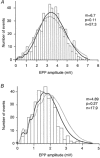Evidence for two distinct processes in the final stages of neurotransmitter release as detected by binomial analysis in calcium and strontium solutions
- PMID: 11897841
- PMCID: PMC2290196
- DOI: 10.1113/jphysiol.2001.013129
Evidence for two distinct processes in the final stages of neurotransmitter release as detected by binomial analysis in calcium and strontium solutions
Abstract
The statistical parameters underlying acetylcholine (ACh) release were studied using Ca(2+) and Sr(2+) ions to promote ACh secretion. Experiments were performed at frog neuromuscular junctions using electrophysiological recording techniques. Increases in asynchronous ACh release, reflected as the frequency of occurrence of miniature end-plate potentials (MEPP(f)), were evoked by high potassium depolarization in either Ca(2+) or Sr(2+) solutions. Increases in MEPP(f) mediated by Ca(2+) were of very low probability and well-described by a Poisson distribution whilst similar MEPP(f) increases mediated by Sr(2+) were best described as a simple binomial distribution. From the binomial distribution in Sr(2+) solutions, values for the average probability of release (p) and the number of releasable ACh quanta (n) may be determined (whereby mean MEPP(f) = np). In Sr(2+) solutions, values of p were independent of both bin width and of the value of n, suggesting that both n and p were stationary. Calculations of p using the simple binomial distribution in Sr(2+) solutions gave theoretical values for the third moment of the mean which were indistinguishable from the experimental distribution. These results, in conjunction with Monte Carlo simulations of the data, suggest that spatial and temporal variance do not measurably affect the analysis. Synchronous ACh release evoked by nerve impulses (end-plate potentials, EPPs) follow a simple binomial distribution in both Ca(2+) and Sr(2+) solutions. Similar mean levels of synchronous ACh release (m, where m = np) were produced by lower values of p and higher values of n in Ca(2+) as compared to Sr(2+). The statistical analyses suggest the presence of two different Ca(2+)-dependent steps in the final stages of neurotransmitter release. The results are discussed in accordance with (i) statistical models for quantal neurotransmitter release, (ii) the role of Sr(2+) as a partial agonist for evoked ACh release, and (iii) the specific loci that may represent the sites of Ca(2+) and Sr(2+) sensitivity.
Figures



Similar articles
-
Effects of calcium and strontium in the process of acetylcholine release from motor nerve endings.J Physiol. 1982 Jul;328:547-62. doi: 10.1113/jphysiol.1982.sp014283. J Physiol. 1982. PMID: 6982330 Free PMC article.
-
Phorbol esters and adenosine affect the readily releasable neurotransmitter pool by different mechanisms at amphibian motor nerve endings.J Physiol. 2003 Dec 1;553(Pt 2):445-56. doi: 10.1113/jphysiol.2003.051300. Epub 2003 Sep 12. J Physiol. 2003. PMID: 12972626 Free PMC article.
-
On the calcium receptor that mediates depolarization-secretion coupling at cholinergic motor nerve terminals.Br J Pharmacol. 1981 Jun;73(2):413-29. doi: 10.1111/j.1476-5381.1981.tb10438.x. Br J Pharmacol. 1981. PMID: 6972242 Free PMC article.
-
Influence of heavy metals on synaptic transmission: a review.Neurotoxicology. 1983 Winter;4(4):69-83. Neurotoxicology. 1983. PMID: 6322059 Review.
-
Transmitter release: prepackaging and random mechanism or dynamic and deterministic process.Brain Res Brain Res Rev. 1990 May-Aug;15(2):167-78. doi: 10.1016/0165-0173(90)90017-i. Brain Res Brain Res Rev. 1990. PMID: 1980833 Review.
Cited by
-
Strontium chloride hexahydrate as a candidate molecule for long-term treatment of allergic rhinitis.Indian J Med Res. 2017 Jul;146(1):121-125. doi: 10.4103/ijmr.IJMR_894_15. Indian J Med Res. 2017. PMID: 29168468 Free PMC article.
-
Mechanisms of neuromodulation as dissected using Sr2+ at motor nerve endings.J Neurophysiol. 2008 Jun;99(6):2779-88. doi: 10.1152/jn.90258.2008. Epub 2008 Apr 2. J Neurophysiol. 2008. PMID: 18385484 Free PMC article.
-
Homeostatic Plasticity of the Mammalian Neuromuscular Junction.Adv Neurobiol. 2022;28:111-130. doi: 10.1007/978-3-031-07167-6_5. Adv Neurobiol. 2022. PMID: 36066823
-
Ca2+ dependence of the binomial parameters p and n at the mouse neuromuscular junction.J Neurophysiol. 2010 Feb;103(2):659-66. doi: 10.1152/jn.00708.2009. Epub 2009 Nov 25. J Neurophysiol. 2010. PMID: 19939953 Free PMC article.
-
Making quantal analysis more convenient, fast, and accurate: user-friendly software QUANTAN.J Neurosci Methods. 2008 Mar 15;168(2):500-13. doi: 10.1016/j.jneumeth.2007.10.006. Epub 2007 Oct 23. J Neurosci Methods. 2008. PMID: 18045692 Free PMC article.
References
-
- Augustine GJ. How does calcium trigger neurotransmitter release. Current Opinion in Neurobiology. 2001;11:320–326. - PubMed
-
- Bai J, Earles CA, Lewis JL, Chapman ER. Membrane-embedded synaptotagmin penetrates cis or trans target membranes and clusters via a novel mechanism. Journal of Biological Chemistry. 2000;275:25427–25435. - PubMed
Publication types
MeSH terms
Substances
Grants and funding
LinkOut - more resources
Full Text Sources
Research Materials
Miscellaneous

